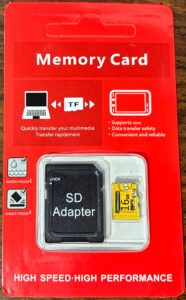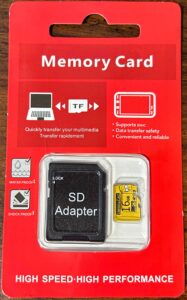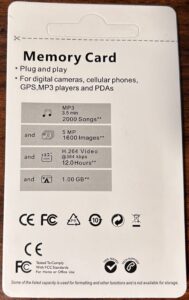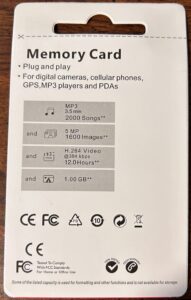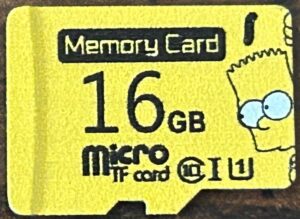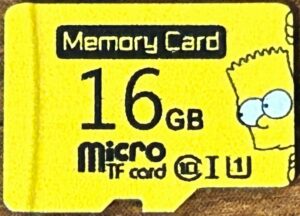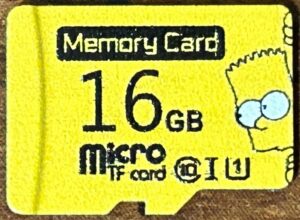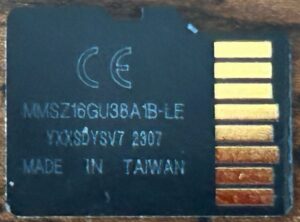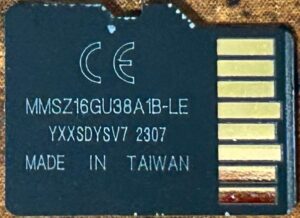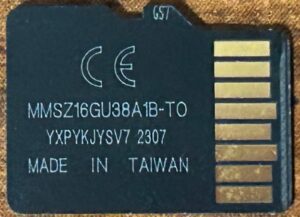- Obtained from: AliExpress
- Price paid: $2.89
- Advertised capacity: 16GB
- Protected area: 134,217,728 bytes
- Speed class markings: Class 10, U1
- CID data:
- Manufacturer ID:
0x6f - OEM ID:
0x0303 - Product name:
0x5344414243(ASCII:SDABC) - Product revision:
0x10
- Manufacturer ID:
Discussion
This is a card that I bought during my first round of SD card purchases from AliExpress, and I very clearly remember the thing that stood out to me about these cards: Bart Simpson peeking in from the side of the card. I’m sure Fox would love to hear about this.
Now, a disclaimer: I think these were sold by Microdrive, but I’m not 100% certain. For the longest time, I had these in my list as simply “Unbranded Simpsons card” because I wasn’t 100% sure they were Microdrive cards. The card itself doesn’t have any brand name on it, and neither does the package it came in — it came in a generic red package that had no brand name, no indication of the size of the card in the package, no speed markings, and no manufacturer information. It’s substantially identical to the packaging that several other off-brand/knockoff/fake cards came in. (What’s funny to me is that the package has a telephone icon that says “tech support” above it, but there’s no indication of where to go to get said tech support — there are no websites, no phone numbers, no mailing addresses…nothing.) However, these cards came from an AliExpress store called “MD Factory Promotional Store”, and many of the other products they sell are Microdrive branded — so I’m choosing to believe that these cards were made by Microdrive as well.
Curiously, sample #2’s CID data indicated a manufacturing date of January 2013 — which would have been more than 10 years before I purchased it — while samples #1 and #3 had more recent dates of May 2023 and June 2023, respectively. When I noticed this, I went back and re-read the CID from the card to make sure I hadn’t made a mistake (such as transcribing the CID value to my spreadsheet by hand and mistyping something) — but alas, I had it correct the first time. Given that sample #2’s packaging didn’t make it look like it had been sitting around for 10 years, I’m inclined to think that its manufacture date was a mistake, and that it was actually made more recently.
Performance measurements on these cards were pretty inconsistent — but overall, were just “meh”:
- Sequential read speeds ran the gamut from “slightly below average” to “slightly above average”. The worst of the three scores would put it into the 31st percentile, while the best would put it into the 60th percentile.
- Sequential write speeds ran the gamut to “below average” to “more than one standard deviation above average”. The worst of the three scores would put it into the 25th percentile, while the best would put it into the 82nd percentile.
- Random read speeds were clustered more closely together — with all three coming close to average. The worst of the three scores would put it into the 43rd percentile, while the best would put it into the 54th percentile.
- Random write speeds ran the gamut from “below average” to “above average”. The worst of the three scores would put it into the 28th percentile, while the best would put it into the 76th percentile.
These cards carry the U1 and Class 10 markings; performance on all three samples was good enough to qualify for both of these markings.
Endurance-wise — these cards actually did pretty well. All three samples made it past the 2,000 read/write cycle mark without errors, making it only one of three models I’ve tested to do so. Samples #2 and #3 are still going:
- Sample #2 has gone 9,367 read/write cycles so far and has not yet experienced any errors.
- Sample #3’s first error was a missing data error that affected around 1.6 million sectors (or about 5.22% of the total sectors on the card) during round 6,974. It has survived 8,013 read/write cycles in total so far.
Overall, I think I’m forced to conclude that these are decent cards. They’re not the best performers in terms of read/write speeds (although sample #3 bucked that trend), but so far they seem to have endured pretty well — sample #1 was the worst performer in this area, and it survived 4,270 before it encountered its first error. Some of the “high endurance” cards I’ve tested have been rated for over 6,000 read/write cycles — so while these cards probably wouldn’t cut it as high endurance cards, they certainly come close (and have fared much better than some other cards I’ve tested).
July 20, 2024 (current number of read/write cycles is updated automatically every hour)


